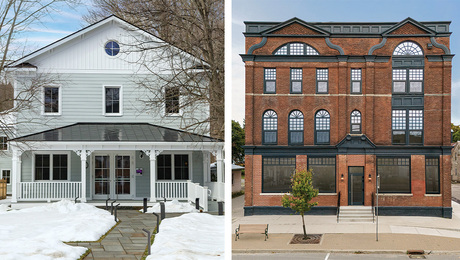Which way best to vent basement bathroom
Have read some good articles in FH about this subject, but still can’t decide which way to vent my Basement Bathroom project.
Method 1: go up vertically up through 1st floor closet .. 10 ft ….. then penetrate cieling.. into attic then angle duct to rear of house then
angle it straight vertically and penetrate roof. Total run in attic would be 20 feet. one 90 and two 45 …Elbows add a lot of resistance
Method 2: ( I have a handicapped style framing – the floor system is recessed, so top is flush with top of concrete basement walls)..so go up into 1st floor and in closet, turn and go horizontally and exit house . would be two 90 elbows and the run only 6-8 feet. It would exit in the watertable board along bottom of house….house has 3 ft overhangs and the exhaust vent would be two feet below a window.
Factoring in things i have read about not exhausting near soffits or windows , but I don’t know what near means as far as ft.
Anythoughts pros and cons on which way to go?
Thanks for taking the time to read my post.



















Replies
I'd take the short run
Think a bit harder on perhaps relocating to miss that window. Get up in the joists and run it over to another exit point, keeping the run short if possible. Your description of how the box of the floor system is in relationship to the foundation confused me............which isn't hard.
But, what is your main concern? The abhorant stink or moisture from a shower? How often is this going to be used? I assume this isn't a living space as it sounds like maybe there's no means of egress other than the stairs up. On this I could be wrong also.
I could locate it offset from window...the window is on a recessed part of the wall and so the vent would be less noticeable...but I could put it on the bump out part of the wall.
The basement is a walkout, but the bathroom is in the farthest corner away from the walkout part. It will get heavy use for a few years by two boys, until they grow up and leave the nest..
The basement is real dry.. exterior perimeter drain tile to daylight ..and the interior drain tile to the sump pit, is always dry.
Poured conc walls have the pink insul foam glued to interior, before the 2 x 4 walls were put up...the 2 x 4 walls are shorter than the conc wall.....so that when the floor joist are placed on these load bearing 2 x 4 walls ( the footings were over sized and offset for this), the top of the floor joists are flush with the sill paltes on top the conc walls..so the main floor subfloor lays on top the joists and the sill paltes..all nice and on the same plain. Then the main floor is framed 2 x 6 over top the sheathing on top the sillplate.
A lot of handicap accesable homes i suppose are done on slabs without basements, but up here basemants are pretty common, so this is a construction detail to get rid of those 2-4 steps at the front porch and again to eliminate them from the garage into the house.
I guess I was wondering if the performace using method two would be noticeable enough better, then i could live with the cosmetic aspect.
About the performance
I have used a remote fan (placed up in the attic ) on a couple occasions to vent bathrooms. The thinking was in a couple cases to vent two rooms with one fan. However, sizing the fan properly to move "more' air than the size of the room dictates, then placing the fan up wind of the location suggests to me that it's performance would be better. Does it make sense that instead of pushing air 30 ft, pulling it 15 then pushing the remainder would work better?
Beats me.
The concern about being near the window ... my guess is that it isn't much of an issue. Unless prevailing wind is DIRECTLY at the window, it wouldn't be an issue. Most anything else will dissipate the moisture/smell fairly quickly. I'd center it below the window to keep it looking like a hodgepodge.
If going up into the attic ... consider a remote fan. I bought a couple of 250 cfm Panasonic whisper fans for like $100 each ... not much more than the hi volume bath fans you buy. You can buy smaller models, I think (or you could keep the larger and improve exhaust flow in other baths using the same fan). Remote location and high volume would resolve your static pressure loss. Put it on a timer or some such. It is very easy to forget it's on ... I frequently do ... you can barely hear it!